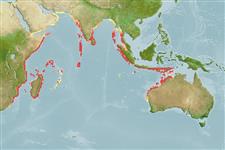Actinopterygii (ray-finned fishes) >
Tetraodontiformes (Puffers and filefishes) >
Balistidae (Triggerfishes)
Etymology: Melichthys: Greek,melis, -itos = honey, a sweet thing + Greek, ichthys = fish (Ref. 45335). More on author: Randall.
Environment / Climate / Range
Ecology
Marine; reef-associated; depth range 1 - 30 m (Ref. 9710). Tropical, preferred ?
Indian Ocean: Red Sea and East Africa eastward to western Thailand and Sumatra, Indonesia.
Size / Weight / Age
Maturity: Lm ? range ? - ? cm
Max length : 25.0 cm TL male/unsexed; (Ref. 4420)
Inhabits coral-rich seaward reef slopes (Ref. 9710, 48637). Occurs singly (Ref. 9710). Digs holes below coral bases for shelter (Ref. 48637). Feeds on sponges, algae, crustaceans and small invertebrates (Ref. 5503). Caught with artisanal gear (Ref. 30573). Minimum depth from Ref. 58018.
Life cycle and mating behavior
Maturity | Reproduction | Spawning | Eggs | Fecundity | Larvae
Oviparous, distinct pairing during breeding (Ref. 205).
Smith, M.M. and P.C. Heemstra, 1986. Balistidae. p. 876-882. In M.M. Smith and P.C. Heemstra (eds.) Smiths' sea fishes. Springer-Verlag, Berlin. (Ref. 4420)
IUCN Red List Status (Ref. 115185)
CITES (Ref. 94142)
Not Evaluated
Threat to humans
Harmless
Human uses
Aquarium: commercial
More information
ReferencesAquacultureAquaculture profileStrainsGeneticsAllele frequenciesHeritabilityDiseasesProcessingMass conversion
Tools
Special reports
Download XML
Internet sources
Estimates of some properties based on models
Phylogenetic diversity index (Ref.
82805): PD
50 = 0.6250 [Uniqueness, from 0.5 = low to 2.0 = high].
Bayesian length-weight: a=0.02570 (0.01237 - 0.05340), b=2.94 (2.76 - 3.12), in cm Total Length, based on LWR estimates for this (Sub)family-body shape (Ref.
93245).
Trophic Level (Ref.
69278): 3.0 ±0.29 se; Based on food items.
Resilience (Ref.
69278): High, minimum population doubling time less than 15 months (Preliminary K or Fecundity.).
Vulnerability (Ref.
59153): Low to moderate vulnerability (28 of 100) .
